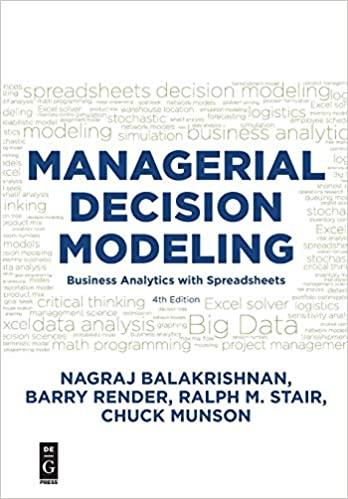Question
Cost Types for our Tennis Hotel: Fixed: Land, Buildings, taxes to government, wages to employees. Service contracts with clients and companies, maintenance and software contract
Cost Types for our Tennis Hotel:
Fixed: Land, Buildings, taxes to government, wages to employees. Service contracts with clients and companies, maintenance and software contract fees, fixed internet & telephone fees, advertising costs, payroll, HR, marketing & sales departments expenses, rents, fixed energy costs
Variable: related to hotel occupancy and business volume. F&B, rooms amenities, stationaries used at the front desk and tennis courts. Entertainment, laundry & other operations, transportation, A&G.
Direct: wages paid to staff, rent paid for buildings,
Indirect: energy expenses, telephone expenses, insurance, depreciation, marketing expenses, rent expenses, general office expenses
Profit Centers for our Tennis Hotel:
The main profit centers of the company are the hotel, restaurant, and spa. The costs that can be assigned to these include the cost of labor, materials, and overhead. The costs that remain general include marketing, administration, and interest.
Tennis enthusiasts will enjoy staying at the Heiltherme Quellenhotel Bad Waltersdorf, which is located in Austria. The hotel, the restaurant, and the spa are the primary contributors to the company's overall profits. The cost of labour, the cost of materials, and the cost of overhead are all examples of costs that might be allocated to these. Marketing, administration, and interest are examples of the costs that are still considered generic.
The hotel contributes the most to the overall profitability of the organisation. The majority of the company's revenues comes from the room rentals and several other hotel services that it provides. It is not difficult to attribute the hotel's labour and material costs to the appropriate profit area. The hotel may also be responsible for overhead costs such as those associated with utilities and upkeep.
The restaurant is the organization's second most important source of revenue and profit. A sizeable amount of the company's overall revenues comes from the proceeds of the selling of food and beverages. The restaurant's labour and material costs can be conveniently attributed to the appropriate profit area with little effort. The restaurant may also be responsible for certain overhead expenditures, such as those associated with utilities and upkeep.
The company's spa is the third most important source of revenue for the business. The income of the company is significantly impacted by the money that is earned from the provision of spa services. It is not difficult to allocate the expenses for the spa's employees and materials to the appropriate profit area. The spa can also be held responsible for overhead expenses such as the cost of utilities and maintenance.
The remaining expenses, which are referred to as general costs, include things like marketing, administration, and interest. These expenditures do not lend themselves well to being categorised under any one of the several profit centres.
The question is : Come up with a full cost / cost plus pricing example based on the information given. How would you allocate overhead costs to the proposed price? Explain the advantages/disadvantages of this pricing approach.
Step by Step Solution
There are 3 Steps involved in it
Step: 1

Get Instant Access to Expert-Tailored Solutions
See step-by-step solutions with expert insights and AI powered tools for academic success
Step: 2

Step: 3

Ace Your Homework with AI
Get the answers you need in no time with our AI-driven, step-by-step assistance
Get Started


